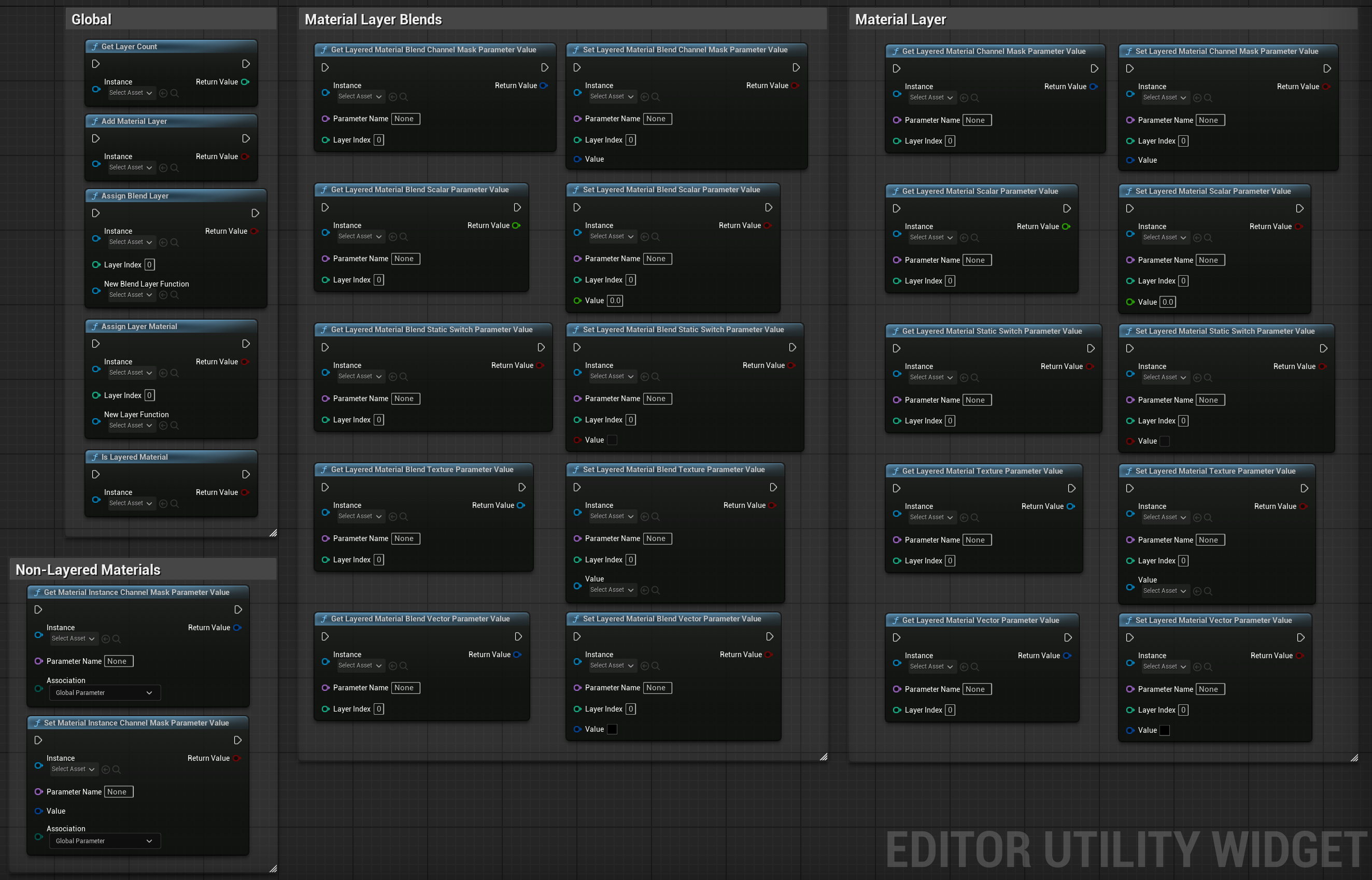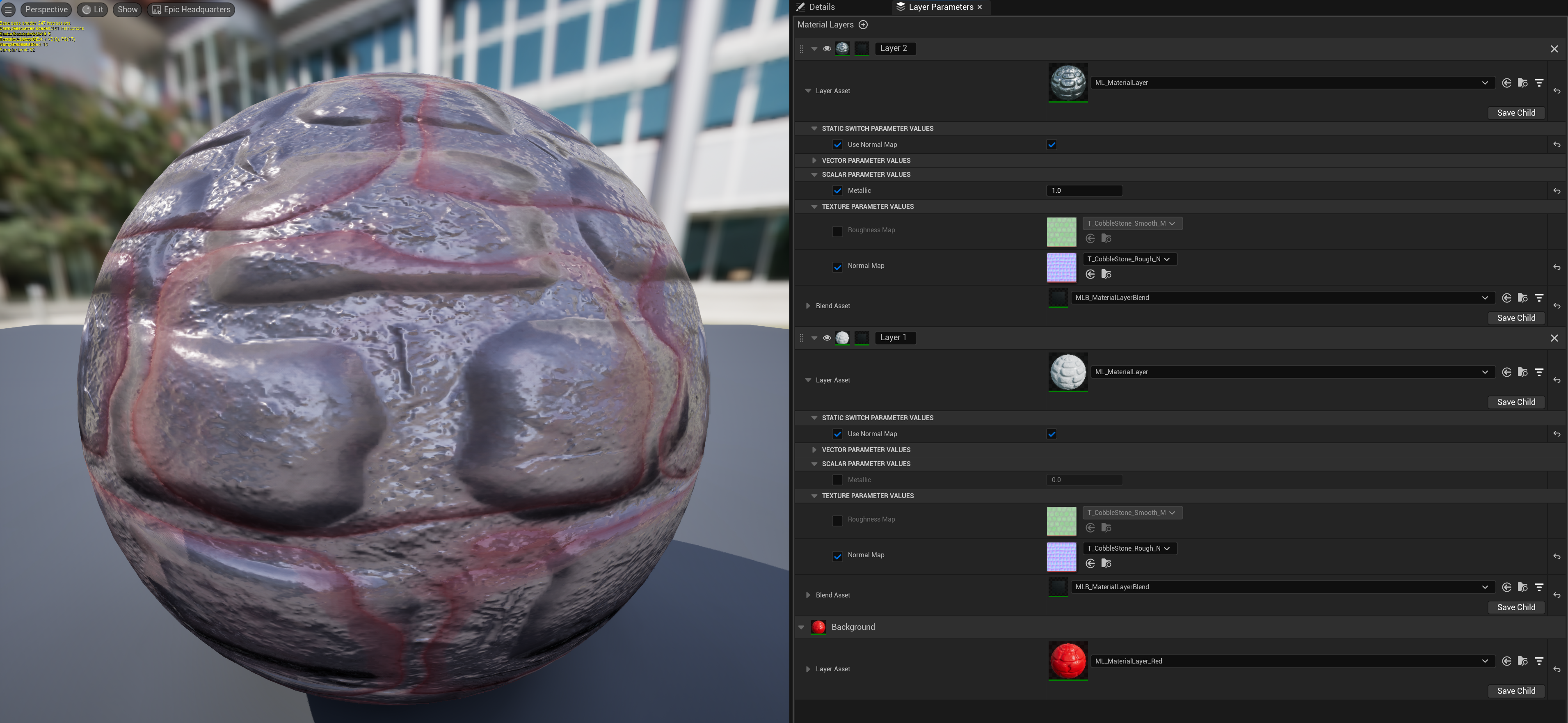UE Advanced Material Editing Library¶
A Unreal Engine 5 plugin that provides functionality to edit material layer and material blend layer parameters through both Python and Blueprints.
Compatibility¶
Builds/binaries are provided in the releases page for UE5.1 to UE5.5.
Note: All versions of this plugin use the same source files.
Table of Contents¶
- Documentation
- Features
- Installation
- Usage
- Blueprints Library
- Blueprint Example
- Python Library
- Simple(ish) Python Example
- Prerequisites
- License
- Contributing
- Getting Help
Documentation¶
View our (to be) comprehensive documentation including:
- API Reference - Comprehensive documentation for Python API
- Git Guide for Beginners - Version control basics explained simply (different project)
Features¶
- Get and set parameters for material layers and blend layers
- Support for different parameter types:
- Scalar parameters
- Vector parameters
- Texture parameters
- Static switch parameters
- Channel mask parameters
- Add and manage material layers programmatically
- Full Blueprint and Python support
- Built-in channel mask constants (Red, Green, Blue, Alpha)
- Type-safe parameter handling
Installation¶
- Download the compatible build for your UE version from the releases page
- Copy the plugin to your project's
Pluginsfolder - Restart Unreal Engine
- Enable the plugin in Edit > Plugins > Materials
Or use the included RebuildPlugin.bat to auto-build the plugin for a new version of UE
Usage¶
Blueprints Library¶
The plugin provides the following Blueprint nodes for Editor Utility Widgets:

Blueprint Example¶
This example would check if a material is layered, if it is, add a new material layer, get the count, and assign a specific material layer asset to it.
Note: These blueprint nodes are ONLY available in Editor Utility Widgets because they adjust elements in-editor, not in-game.

Python Library¶
The plugin provides a convenient LayeredMaterialLibrary class with static methods for material manipulation. When
the plugin is added to your project, you can access it via:
from layered_material_library import LayeredMaterialLibrary
Simple(ish) Python Example¶
The following example shows a way to approach using the python library that comes with the plugin. While it only shows the process of getting and setting values on a Material Layer, it works almost the exact same way for Material Layer Blend assets.
from layered_material_library import LayeredMaterialLibrary
import unreal
# Load required assets
material_instance = unreal.load_object(None, '/AdvancedMaterialEditingLibrary/Examples/MI_TargetMaterial')
simple_layer = unreal.load_object(None, '/AdvancedMaterialEditingLibrary/Examples/ML_MaterialLayer')
red_layer = unreal.load_object(None, '/AdvancedMaterialEditingLibrary/Examples/ML_MaterialLayer_Red')
blend_function = unreal.load_object(None, '/AdvancedMaterialEditingLibrary/Examples/MLB_MaterialLayerBlend')
# Check material properties
print(f"Material instance is layered material: {LayeredMaterialLibrary.is_layered_material(material_instance)}")
print(f"Initial layer count: {LayeredMaterialLibrary.get_layer_count(material_instance)}")
# Add and configure layers
LayeredMaterialLibrary.assign_layer_material(material_instance, 0, red_layer) # Set base layer to a new material
LayeredMaterialLibrary.add_material_layer(material_instance) # Add second layer
LayeredMaterialLibrary.assign_layer_material(material_instance, 1, simple_layer)
LayeredMaterialLibrary.assign_blend_layer(material_instance, 1, blend_function)
LayeredMaterialLibrary.add_material_layer(material_instance) # Add third layer
LayeredMaterialLibrary.assign_layer_material(material_instance, 2, simple_layer)
LayeredMaterialLibrary.assign_blend_layer(material_instance, 2, blend_function)
# Modify layer parameters
# For all parameter names, they just need to match whatever label you set for them when you created
# the master material/material layer/material layer blend.
def modify_layer_parameters(layer_index: int, metallic: float = 0):
"""Example of a function that could modify parameters of different kinds.
When a parameter is set, the checkbox to enable editing it is enabled, even if the value was not
changed. I do a test below with the scalar value before setting to avoid enabling the parameter
if it isn't necessary.
Args:
layer_index: The layer index to search for the parameter on
metallic: Example argument for a value you could set on a scalar value.
"""
# Scalar parameter example
metallic_value = LayeredMaterialLibrary.get_layered_material_scalar_parameter_value(
material_instance, 'Metallic', layer_index
)
if metallic_value != metallic:
LayeredMaterialLibrary.set_layered_material_scalar_parameter_value(
material_instance, 'Metallic', layer_index, metallic
)
# Static switch example
LayeredMaterialLibrary.set_layered_material_static_switch_parameter_value(
material_instance, 'Use Normal Map', layer_index, True
)
# Texture parameter example - Requires StarterContent
texture = unreal.load_object(None, '/Game/StarterContent/Textures/T_CobbleStone_Rough_N')
LayeredMaterialLibrary.set_layered_material_texture_parameter_value(
material_instance, 'Normal Map', layer_index, texture
)
# Modify parameters for the layers
modify_layer_parameters(layer_index=1, metallic=0)
modify_layer_parameters(layer_index=2, metallic=1)
# Verify changes
print(f"Final layer count: {LayeredMaterialLibrary.get_layer_count(material_instance)}")
print(f"Layer 1 Metallic value: {LayeredMaterialLibrary.get_layered_material_scalar_parameter_value(material_instance, 'Metallic', 1)}")
print(f"Layer 1 Normal Map enabled: {LayeredMaterialLibrary.get_layered_material_static_switch_parameter_value(material_instance, 'Use Normal Map', 1)}")
print(f"Layer 2 Metallic value: {LayeredMaterialLibrary.get_layered_material_scalar_parameter_value(material_instance, 'Metallic', 2)}")
print(f"Layer 2 Normal Map enabled: {LayeredMaterialLibrary.get_layered_material_static_switch_parameter_value(material_instance, 'Use Normal Map', 2)}")
If you copy-paste the above into an Unreal Engine terminal (Output Log set to Python is my preference)
you should get the following result when you view the material at /AdvancedMaterialEditingLibrary/Examples/MI_TargetMaterial

Prerequisites¶
- Unreal Engine 5.1 or later
License¶
This project is licensed under the MIT License - see the LICENSE file for details.
Contributing¶
The project is small, I'm not sure it can expand much but feel free to contribute! If you're new to open source check out:
- My Git Guide for version control basics
- GitHub's guide on Creating a Pull Request
- The issues page for beginner-friendly tasks
Getting Help¶
- Open an issue for bugs or feature requests
- Check troubleshooting for common issues
- Review existing issues before creating new ones
- Don't hesitate to ask questions - I'm here to help!


